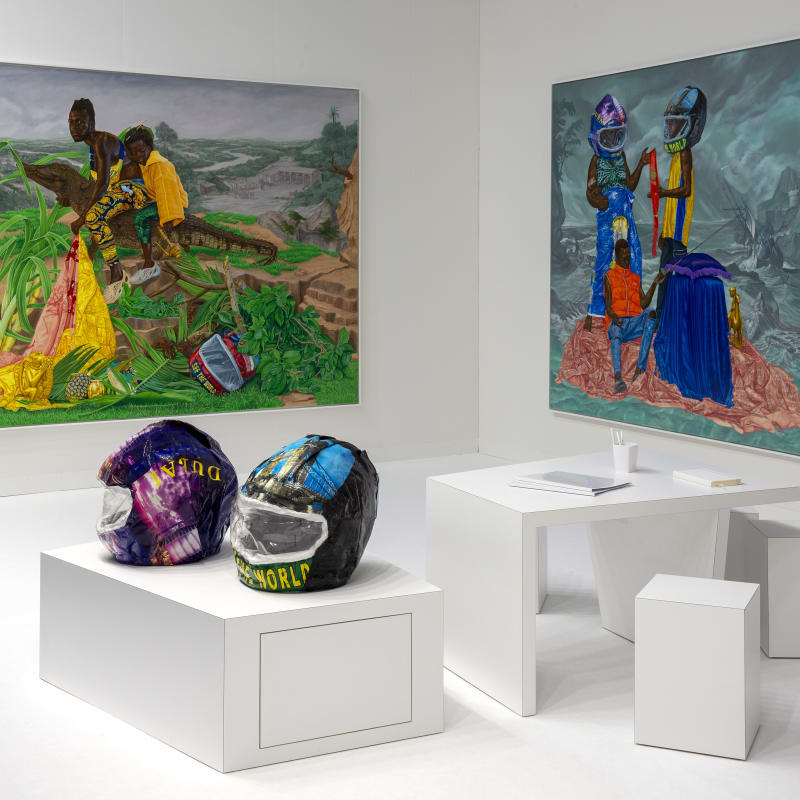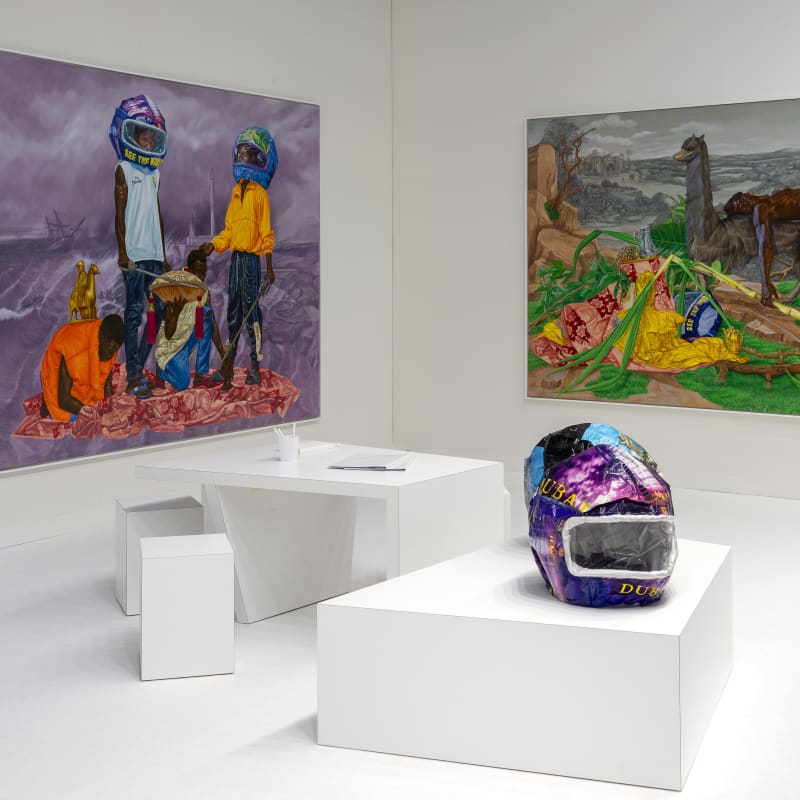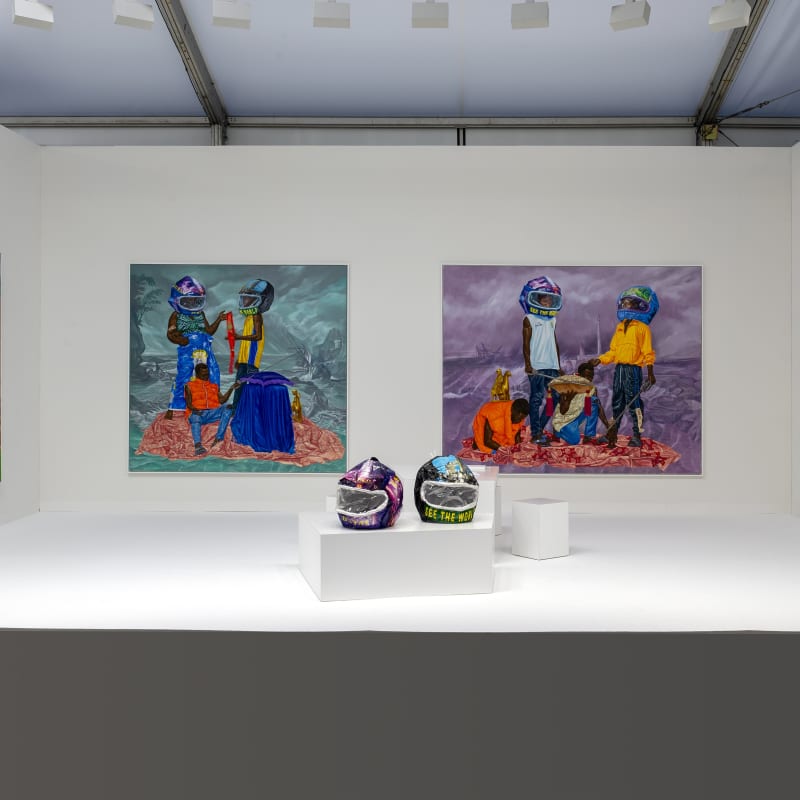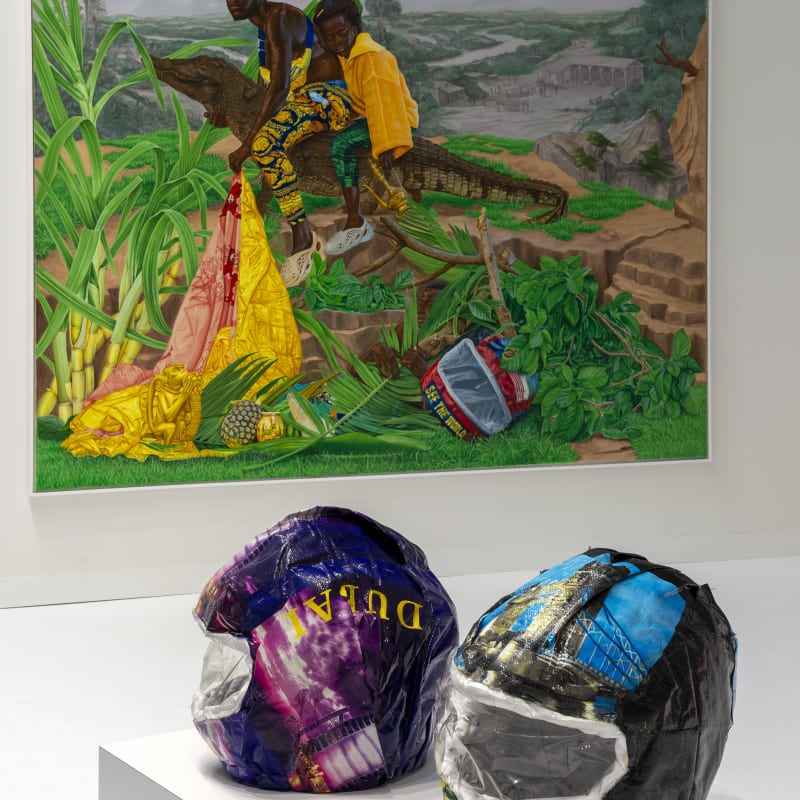Booth E08
www.parisplus.artbasel.com
A place, objects, characters. On an often monochrome background as a story, the heroes of Hilary Balu stand out. Each canvas is a setting and each series is a chapter in the African odyssey. Let’s look at those who leave: families far from being tourists, men reduced to merchandise, children who dream of power. Hilary Balu’s last two chapters In the Floods of Illusions and From Fantasy to Escape take us into space, on the seas and in the forest, in search of a lost history, relived, sadly, ironically re-found. Along their journey, these exhausted heroes discover the prejudices that were put in their heads, they rediscover the origin of the venerated objects, they are dressed in purple fabrics, blue and yellow clothes. The colors seize us.
Hilary Balu leads our eye in a fresco with an impressive composition; reminiscences of Turner's tumultuous seas; remnants of Frans Post's landscapes, where the African man is no longer this tiny character in the background, a slave, but the man in the center, large, with his expressions of piety, with his weary postures as if he was always embarked in spite of himself, passive, reified, stolen. Some looks are distant. Others turn towards us and seem to say: "You see? Unlike Ulysses, the white hero who fought in foreign lands and wandered to find his Ithaca, Hilary Balu's characters leave their native land and accost the regions of the world that once exploited them. And if the Trojans did not flee to Greece, the youth of the Democratic Republic of Congo, without knowing it, reproduce the trajectory of the slaves.
“I remember that as a child, I had trouble eating jam and every time my parents told me that I had to eat it, because it was the food of white people. Later, my friends and I fantasized a lot about going to Europe on foot. I wanted to question these fantasies, these complexes we had about Europe, the paved continent. But more than that, I wanted to understand how these complexes came to us and in us.“
Hilary Balu seeks the escape point, the origin of the departure. His series is a journey through space and time, from the 15th century to the present, from European capitalism to slavery, from the dreams and fantasies implanted in a child’s mind, to the admiration of the Kongo kings for the objects imported by the Portuguese. The story told by Balu is the irony of history, the continuity of violence, the imagination that pushes the exploited to return to the country of the exploiters.
The journey began in the farthest, in space. Voyage vers Mars (2020) metaphorically stages the contemporary migration of a population, transformed by capitalism and the consumer society. The other is another planet. The cosmonauts, an allegory of the migrant, leave a land that has become uninhabitable, plagued by conflicts and economic difficulties. Ironically, the luggage of these forced travelers is made up of tourist bags displaying the decorations of the world’s capitals - thus the flip-flops and Nkisi Mangaaka, an ancestral divinatory sculpture, are mixed together.
In the floods of illusions
The journey continues on the seas: The water is inhabited by ghosts, illusions, memories and dreams, says Hilary Balu. Traditionally, from a capitalist perspective, people go to sea for powerful interests, for trade. But in this series, interests are chimeras. Water is the element of dreams. The Kongo culture had an image of the ocean as a mythical and impenetrable world, a fantasy that the artist recalls by drawing inspiration from 19th century European paintings, such as those of Turner, a fantasy according to which better would be elsewhere.
From fantasy to escape
The last journey takes place in America. Hilary Balu tells us about the North-South relations that took place between the 16th and 17th centuries, as well as the consequences on contemporary African society. Understanding the slave trade, the crossing to this new land that Europe prepared for them, or rather, for the capitalist system whose tools they are. The question is asked: why do Africans today dream of the West? Why do they follow, by themselves, through the forests, in Brazil, the same paths that their ancestors took? This series makes the link between these two eras - from fantasy to escape. To do so, Balu invites us to revisit the paintings of Frans Post, the Dutch painter: “When you look at Frans Post, you see landscapes. We see wild animals, the exotic world of Brazil. We think it’s a naturalist view, but it’s nothing but a colonial view. Frans Post’s space is a conquest of the black body, the African body, to feed the global enterprise of slavery. For me, taking up Post is a way of challenging European fantasy.“
About the artist
Hilary Balu’s desire to be an artist began as a child. He copied images from movies, trailers, posters, as well as his father’s drawings who occupied his free time by reproducing objects in the house. With the help of his aunts and uncles, he obtained from his father to follow an artistic education. He studied at the Academy of Fine Arts in Kinshasa. As a young graduate, during a conversation at an opening of the artist Vitshois Mwilambwe Bondo in Kinshasa, Hilary Balu sees his academic convictions shaken. He emancipates himself from Western codes and techniques learned at school, and seeks an aesthetic with which he can identify as a Congolese but also as an African.
Hilary Balu’s paintings reveal an African society transformed by globalization and consumerism. The «brutal mutation» that the Democratic Republic of the Congo has experienced in its cultural, political, economic and spiritual identity is represented through a symbolism of the object. The artist sets it up as a collective memory.
Born in 1992 in Kinshasa, Democratic Republic of the Congo where he lives and works, Hilary Balu was resident in 2021 at Black Rock Senegal, an artist residency founded by Kehinde Wiley. His works are held in the collections of The Jean Pigozzi Collection of African Art, Geneva; Farida and Henri Seydoux Collection, Paris; CBH Collection, Geneva.






